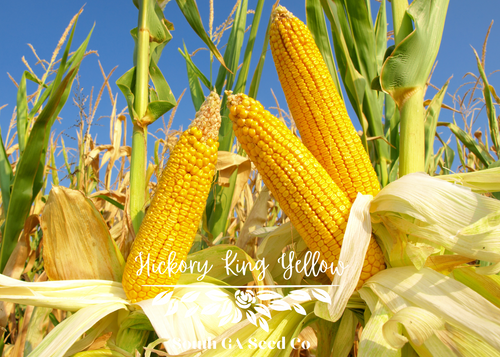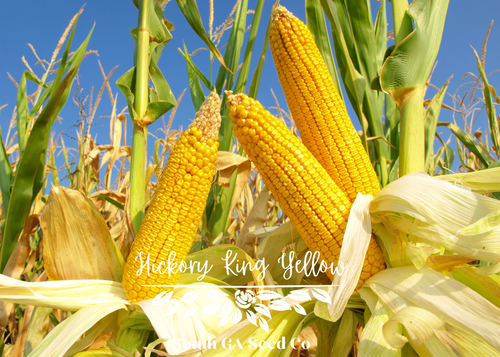★ Organically grown on our farm
Hickory King Yellow Corn, a beloved heirloom variety cherished by gardeners and farmers for generations. This distinctive corn is a testament to agricultural history and a staple in kitchens and gardens across the country. Known for its large kernels and robust flavor, this time honored heirloom offers a taste of tradition with every bite. With its exceptionally large kernels, Hickory King Yellow Corn is ideal for making hominy, grits, and cornmeal, making it a favorite for culinary uses. The corn grows impressively tall, reaching up to 12 feet, making it not only a bountiful producer but also a striking addition to any garden landscape. Perfect for both fresh eating and processing, this corn can be enjoyed in various ways, whether roasted on the cob, ground into meal, or used in traditional recipes.
Suitable for a range of climates, this adaptable and resilient corn thrives in both small gardens and large farms. Best planted in the warm season after the risk of frost has passed, it requires full sun and well drained soil for optimal growth. Space the seeds about 8 to 12 inches apart, and ensure consistent watering to support its tall growth and kernel development. Typically ready for harvest in 110 t0 120 days, the ears should be picked when the kernels are plump and full for maximum flavor. Embrace the rich history and culinary versatility of Hickory King Yellow Corn. Whether you’re an avid gardener, a culinary enthusiast, or someone who appreciates quality produce, this heirloom corn variety is a remarkable choice.
- QTY: 50
- Seed Planting Depth: 1-2
- Germination Temperature: 70-80
- Days to Germination: 4-8
- Row Spacing: 12-24"
- Plant Spacing: 6-8"
- 100' Row Yield: 15 lb
- Sun: Full
- Harvest time: 95 days
How to Save Seeds
Corn will cross pollinate with other corn varieties and readily. Therefore it is recommended to separate by at least 1 mile. Let seeds dry in stalk but don't tarry in fact make sure to harvest as soon as dry. Also make sure to collect from at least 100 separate corn plants to have a healthy batch of corn next year. Rub corn off cobs when dry and store.









